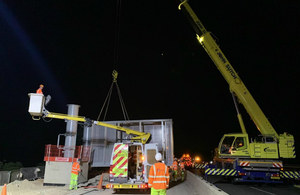Highways England puts the bins out for roadside collections in South West
The Government company, which is responsible for operating, maintaining and improving the country’s motorways and major A roads, has pumped £80,000 into an initiative to help keep counties in the South West beautiful.
Councils are responsible for clearing litter from the majority of A roads, and after local authorities in the South West identified the worst littered laybys in their areas, Highways England has installed bins and ‘keep it tidy’ signs in 14 laybys, to encourage drivers not to litter.
The scheme follows the installation of layby signage along the A30 and A38 in Devon and Cornwall last year, and the initiative is not only targeted at reducing the amount of roadside litter, and improving the lives of both communities and motorists, but it is also aimed at providing a time and cost saving for local authorities.
Chris Regan, South West Head of Service Delivery for Highways England, said:
Litter is unsightly and a threat to wildlife and the environment.
It’s a safety hazard for drivers and roadworkers risk their lives collecting it. That’s besides the cost which would be better spent on maintaining our roads.
We’re hoping this layby work will make a difference, for both communities and our local authority partners. And our advice to drivers is clear: please use the bins, heed the signage, and don’t drop litter. Keep a bag in your car to store litter until you can dispose of it responsibly.
The partnership with Wiltshire, South Gloucestershire, Bath & North East Somerset, Tewkesbury Borough, Gloucester City and Forest of Dean Councils is tackling litter along the A36, A303, A46, A4 and A40.
Councillor Bridget Wayman, Wiltshire Council Cabinet Member for Highways, said:
We are pleased this initiative to reduce litter on Wiltshire’s major roads has been completed and we look forward to seeing the impact these bins and signs have, as lockdown eases and people start to travel more.
Wiltshire is a beautiful county and we are committed to keeping it that way, so please, use these bins and help to keep our laybys litter free.
Councillor Steve Reade, South Gloucestershire Council Cabinet Member for Planning, Transport and the Strategic Environment, said: “We share our residents’ desire to see the South Gloucestershire countryside looking green and its streets clean, and we know that overwhelmingly people do the right thing when we make it easier for them.
This Highways England investment is most welcome as it further demonstrates that keeping our world clean and tidy is something we all need to play our part in. There can be no excuse for littering on the roadside, or anywhere else, as the financial cost to us as a council and the environmental cost to everyone is simply too high.
The scheme includes the following hot spots:
- A303: Longbarrow eastbound; Berwick St James westbound and eastbound
- A36: Berkley northbound; Crockerton northbound and southbound; Cley Hill southbound
- A40: Highnam westbound; Birdwood eastbound, Longford southbound; Churcham westbound
- A46: Bath northbound and southbound
- A4: Bath westbound
Around 200,000 bags of litter are collected from Highways England’s motorways every year, figures have shown, and the company will be taking part in Keep Britain Tidy’s Great British September Clean (11-27 September) following the cancellation of the Great British Spring Clean.
General enquiries
Members of the public should contact the Highways England customer contact centre on 0300 123 5000.
Media enquiries
Journalists should contact the Highways England press office on 0844 693 1448 and use the menu to speak to the most appropriate press officer.

